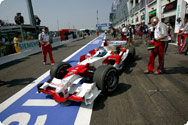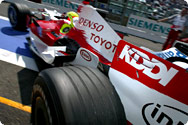Thank you for your continued support. The start of the second half of the 2006 season sees us return to Europe. Here is my report from the French Grand Prix.
Confident that this time, both cars will finish at the top
 |
 |
| As opposed to the ultra-high-speed
United States Grand Prix, Magny-Cours demands more downforce. Panasonic Toyota
Racing made several changes, including the addition of small winglets to the
front wing. |
|
 |
Having completed back-to-back races in North America, we have returned
now to Europe. In comparison to the last two races, this course requires more
of a high downforce setting, so we have brought new front and rear wing specifications
to match the characteristics of this circuit. America was quite warm, but France
is much hotter than normal for this time of year, so we have prepared engine
and brake cooling specifications that should allow us room enough to deal with
the heat.
We have come to each race with incremental improvements here and there, but
looking back over the first half of the championship, I really feel that our
performance has improved considerably from where we were at the beginning of
the season.
Unbowed by the heat; completing a smooth free practice program
Jarno had an “oops” moment during Friday’s free drive, just
missing his line in the hairpin. Other than that, Friday’s practice progressed
quite smoothly, and we were able to complete our program as planned. Jarno’s
incident happened on the first lap of the circuit, but the car’s brakes
locked, and the car ran out onto the gravel. We decided to replace the car’s
rotors and pads when Jarno came back into the pits, after which he continued
to take laps around the circuit. My take on the situation was that rather than
being some type of trouble, the brakes were just cold.
 |
 |
| |
The French GP is held during a very hot time of
the year. While the teams must take special measures to cool the brakes and chassis,
this is also a race in which the drivers must fight the debilitating effects
of extremely hot weather. |
 |
As always, both drivers helped us compare tire compounds, which we evaluated
as “good.” I picked up a nearby thermometer, measuring the track
surface at 49°C. It was a little hotter than we anticipated, but both tire
specs we brought exhibited stable performance. We were on schedule to make our
spec selection before qualifying, keeping a close eye on tire wear and graining
together with the Bridgestone engineers.
With the first day of driving behind us, the lasting impression was of the
difficulties presented by the last chicane and the curbs in the Turn 6 and Turn
7 complex. The curb on the last corner is not very tall, but the curbs are much
higher in these two spots, making the chassis jump and then bottom out on the
landing. One of the biggest issues we face here is how to come to terms with
bottoming out.
Continued favorable progress; both cars qualify in the top five
I think you could say that today’s results were very good for us. Jarno
matched his best qualifying performance of the season at P4, and Ralf was very
close behind at P5. To this point in the season, Panasonic Toyota Racing hasn’t
been able to get both cars through an entire race. Our ambition going in here
is to get both cars to complete the race, and have both cars finish in the points.
 |
|
| The team reported that
the Bridgestone tires matched the conditions extremely well, and that both tire
compounds provided terrific feel, which actually made it difficult to select
a tire spec to use in the race. |
 |
 |
I think Friday and Saturday morning practices provided plenty of momentum
leading to our qualifying results. P4 and P5 on the grid were exactly what we
were expecting. We experienced two days of trouble-free practice on Friday and
Saturday, and both of our drivers performed very admirably in the heat. The tires
also performed very well, for which I think we owe Bridgestone a word of thanks.
During Q1 (first qualifying period), we thought we would be fine running on
used tires, and that we would be able to record a time fast enough to get us
through to Q2. However, we did want to check our performance on new tires, so
we did one more time attack just prior to the end of the session. We always make
two time attack laps during Q2, but we recorded a very strong time in our first
attack lap, so we decided to prepare for a second hot lap, and then wait to see
how things developed. In the end, it looked like we were fine, so we let the
session expire without attempting another attack lap. At least this time around
we had some room to play with in qualifying.
Finishing in the points three races in a row builds our confidence for the future
Winning points in three consecutive races, now, I think we have built up quite
a bit of confidence, and I think we are capturing good results. Despite the fact
that I have continued to say that we want both cars to complete a race and win
strong finishes, we haven’t yet been able to do that. This is both disappointing,
and unavoidable to a certain extent.
| |
 |
 |
Both Jarno and Ralf drove a first stint strong
enough to think about a podium finish, but mechanical problems forced Jarno to
retire. Ralf took over to capture 4th for Panasonic Toyota Racing. While this
race held some disappointments, consecutive top finishes have created a strong
air of confidence for Panasonic Toyota Racing. |
 |
Jarno experienced a leak in his brake line system, and had to retire from
the race. Jarno reported back to us that he had started to feel a problem with
the brake pedal getting softer. He came into the pits, where we changed his tires
and sent him back out on the course. Unfortunately, the problem couldn’t
be ignored, and Jarno came back into the pits on the next lap.
Things had progressed very smoothly through the first stint. Immediately after
the start of the second stint, Jarno complained about the engine power dropping
off. We definitely plan to look into this issue when we get back to TMG headquarters.
There were no problems our engineers could detect after the race, but this was
the second race on Jarno’s engine, so it definitely had run its share of
mileage.
Our starts had been a concern for us, but both cars were able to protect their
positions this time. We believed that we would be able to leave our cars on the
course longer than the others during the first stint, and with a two-stop strategy,
we figured that if we could stay with the lead cars, we could take advantage
of one less pit stop to end with a strong result.
I think our pace during the race was very good. I was thinking that if things
developed favorably for us, we might get one of our cars into the top three.
Unfortunately, Ralf also ran into some problems. During his first pit stop, we
wasted some time changing the rear tires, which caused Ralf to lose position
out on the course. After that, Ralf was caught behind Renault’s Giancarlo
Fisichella, preventing Ralf from increasing pace. Everything went smoothly during
Ralf’s second pit stop, and he was able to recapture his original position
in the race. Looking back from a perspective of our overall performance on the
day, I would have to say that we had a good race.
Jarno’s car trouble was truly unfortunate, especially since we have
been successful in steadily upgrading our car’s performance. This progress
has been the source of an upbeat atmosphere among the team. The next race at
Hockenheim is very close to the TMG home base, so we all want very much to have
both cars finish the race and turn in a strong performance. We will be working
very hard over the next two weeks, and we ask for your continued support.
|